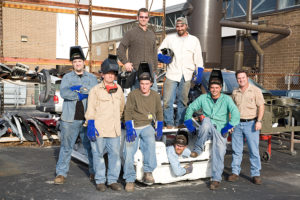Manufacturing provided financial stability for America’s middle class by employing as many as 17 million people annually from mid-century through the end of the 1990s. At its peak in 1953, the sector accounted for 28.3% of the country’s gross domestic product (GDP) and, together with agriculture, employed one of every three American workers in the years following World War II. Since then, the overall percentage of manufacturing GDP outside computers and electronics has been declining, according to the Journal of Economic Perspectives article. Manufacturing had dropped to just 11% of the country’s GDP output and accounted for to one of every eight jobs, according to The Atlantic article, by the end of the 2007-2009 Great Recession.
Recession woes
 The 2007-2009 recession brought devastation to the manufacturing sector because consumers slowed spending as they struggled through housing and financial services collapses. Reduced spending meant less buying. This trickled down to manufacturing, in which hiring slowed, layoffs increased, and hiring eventually stopped in some plants; producers canceled new equipment orders; and marketing and sales teams dropped efforts accordingly.
The 2007-2009 recession brought devastation to the manufacturing sector because consumers slowed spending as they struggled through housing and financial services collapses. Reduced spending meant less buying. This trickled down to manufacturing, in which hiring slowed, layoffs increased, and hiring eventually stopped in some plants; producers canceled new equipment orders; and marketing and sales teams dropped efforts accordingly.
To reduce costs, some company leaders sent their manufacturing processes overseas, and many of them weathered the recession because of those cost reductions. However, offshoring industrial activities redirected economic resources out of the country and eliminated American manufacturing jobs, which exacerbated the financial downturn’s effect.
At the same time, the skills gap within the industry was widening. As the number of sophisticated manufacturing technologies grew and replaced human workers, the number of tradespeople skilled in managing those operations dropped. The lack of qualified employees hampered the industry even before the Recession began, and some have commented that America’s education system does not meet the demands of today’s employers. With little or no pre-employment training available, potential workers don’t get the education they need to excel in these technological positions.
A rebounding economy
 Despite a general recovery across the American economy, the manufacturing sector has yet to reach its pre-2007 output levels. Although it experienced rapid regrowth in the five years after the economy hit its low point, the industry has since struggled with political instability and the continuing skills gap.
Despite a general recovery across the American economy, the manufacturing sector has yet to reach its pre-2007 output levels. Although it experienced rapid regrowth in the five years after the economy hit its low point, the industry has since struggled with political instability and the continuing skills gap.
Recent successful efforts to reshore manufacturing, however, have brought jobs back to America. The drive to generate jobs has spurred U.S. manufacturers to re-home their factories and operations on American soil, and those efforts created 77,000 new jobs in 2016. A “re-education” wave could offer further opportunities to train worker in the skills today’s complex manufacturing technologies demand.
